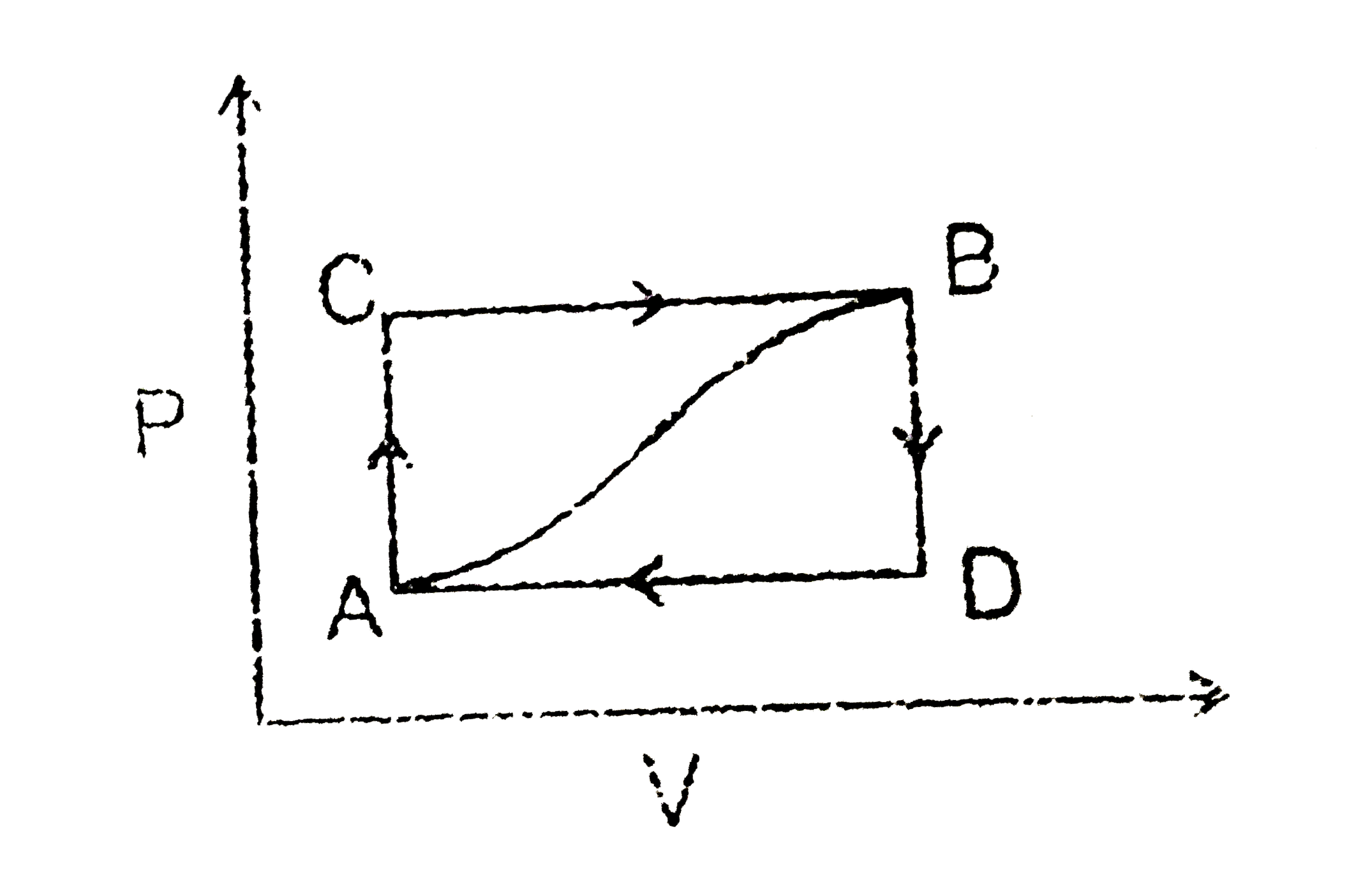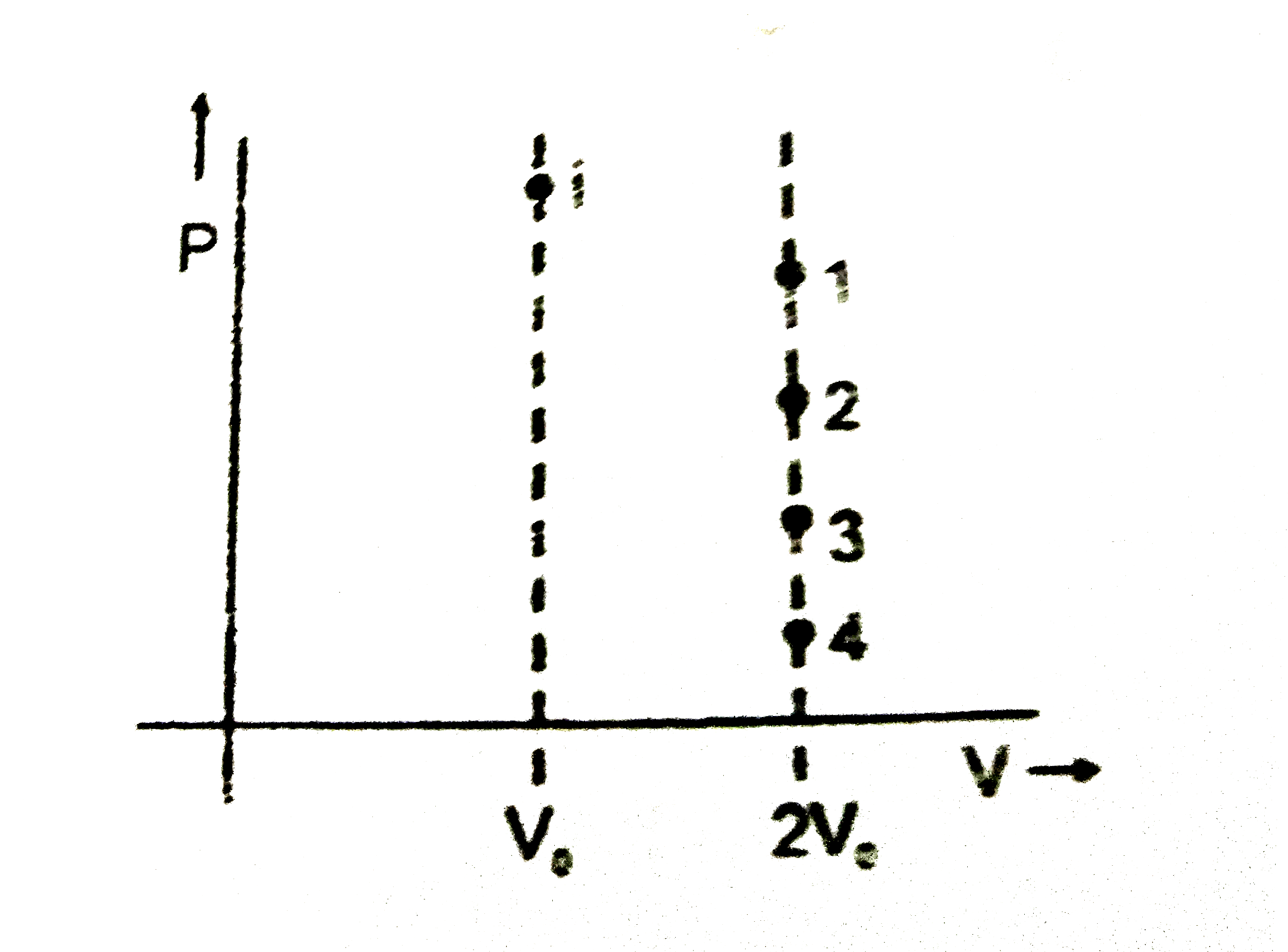Complete Solutions to Exercise-2 part -IV : Comprehension of chapter THERMODYNAMICS of Class 12 book with complete answers and questions
| Class 12 | CHEMISTRY |
| Chapter | THERMODYNAMICS |
| RESONANCE | Exercise-2 part -IV : Comprehension |
| Number Of Questions | 11 |
| Academic Year | 2023-24 |
When a system is taken from state `A` to state `B` along path `ACB` as shown in figure below, `80 J` of heat flows into the system and the system does `30 J` of work.

How much heat flows into the system along path `ADB` if the work done by the system is `10 J`:01:49View SolutionWhen a system is taken from state `A` to state `B` along path `ACB` as shown in figure below, `80 J` of heat flows into the system and the system does `30 J` of work.

When the system is returned from state `B` to `A` along the curve path, the work done on the system is `20 J`.
Does the system absorb or literate heat and by how much ?02:12View SolutionWhen a system is taken from state `A` to state `B` along path `ACB` as shown in figure below, `80 J` of heat flows into the system and the system does `30 J` of work.

If `E_(D)-E_(A)= -40 J`, the heat absorbed in the processes `AD` and `DB` are respectively03:06View SolutionA gaseous sample is generally allowed to do only expansion`//`compression type work against its surroundings The work done in case of an irreversible expansion ( in the intermediate stages of expansion`//`compression the states of gases are not defined). The work done can be calculated using
`dw= -P_(ext)dV`
while in case of reversible process the work done can be calculated using
`dw= -PdV` where `P` is pressure of gas at some intermediate stages. Like for an isothermal reversible process. Since `P=(nRT)/(V)`, so
`w=intdW= - underset(v_(i))overset(v_(f))int(nRT)/(V).dV= -nRT ln(V_(f)/(V_(i)))`
Since `dw= PdV` so magnitude of work done can also be calculated by calculating the area under the `PV` curve of the reversible process in `PV` diagram.
If four identical samples of an ideal gas initially at similar state `(P_(0),V_(0),T_(0))` are allowed to expand to double their volumes by four different process.
I: by isothermal irreversible process
II: by reversible process having equation `P^(2)V=` constant
III. by reversible adiabatic process
IV. by irreversible adiabatic expansion against constant external pressure.
Then, in the graph shown in the final state is represented by four different points then, the correct match can be
 03:24View Solution
03:24View SolutionA gaseous sample is generally allowed to do only expansion`//`compression type work against its surroundings The work done in case of an irreversible expansion ( in the intermediate stages of expansion`//`compression the states of gases are not defined). The work done can be calculated using
`dw= -P_(ext)dV`
while in case of reversible process the work done can be calculated using
`dw= -PdV` where `P` is pressure of gas at some intermediate stages. Like for an isothermal reversible process. Since `P=(nRT)/(V)`, so
`w=intdW= - underset(v_(i))overset(v_(f))int(nRT)/(V).dV= -nRT ln(V_(f)/(V_(i)))`
Since `dw= PdV` so magnitude of work done can also be calculated by calculating the area under the `PV` curve of the reversible process in `PV` diagram.
If four identical samples of an ideal gas initially at similar state `(P_(0),V_(0),T_(0))` are allowed to expand to double their volumes by four different process.
I: by isothermal irreversible process
II: by reversible process having equation `P^(2)V=` constant
III. by reversible adiabatic process
IV. by irreversible adiabatic expansion against constant external pressure.
Then, in the graph shown in the final state is represented by four different points then, the correct match can be
 03:24View Solution
03:24View SolutionA gaseous sample is generally allowed to do only expansion`//`compression type work against its surroundings The work done in case of an irreversible expansion ( in the intermediate stages of expansion`//`compression the states of gases are not defined). The work done can be calculated using
`dw= -P_(ext)dV`
while in case of reversible process the work done can be calculated using
`dw= -PdV` where `P` is pressure of gas at some intermediate stages. Like for an isothermal reversible process. Since `P=(nRT)/(V)`, so
`w=intdW= - underset(v_(i))overset(v_(f))int(nRT)/(V).dV= -nRT ln(V_(f)/(V_(i)))`
Since `dw= PdV` so magnitude of work done can also be calculated by calculating the area under the `PV` curve of the reversible process in `PV` diagram.
In the above problemView SolutionA gaseous sample is generally allowed to do only expansion`//`compression type work against its surroundings The work done in case of an irreversible expansion ( in the intermediate stages of expansion`//`compression the states of gases are not defined). The work done can be calculated using
`dw= -P_(ext)dV`
while in case of reversible process the work done can be calculated using
`dw= -PdV` where `P` is pressure of gas at some intermediate stages. Like for an isothermal reversible process. Since `P=(nRT)/(V)`, so
`w=intdW= - underset(v_(i))overset(v_(f))int(nRT)/(V).dV= -nRT ln(V_(f)/(V_(i)))`
Since `dw= PdV` so magnitude of work done can also be calculated by calculating the area under the `PV` curve of the reversible process in `PV` diagram.
If four identical samples of an ideal gas initially at similar state `(P_(0),V_(0),T_(0))` are allowed to expand to double their volumes by four different process.
I: by isothermal irreversible process
II: by reversible process having equation `P^(2)V=` constant
III. by reversible adiabatic process
IV. by irreversible adiabatic expansion against constant external pressure.
Then, in the graph shown in the final state is represented by four different points then, the correct match can be
 03:24View Solution
03:24View SolutionA gaseous sample is generally allowed to do only expansion`//`compression type work against its surroundings The work done in case of an irreversible expansion ( in the intermediate stages of expansion`//`compression the states of gases are not defined). The work done can be calculated using
`dw= -P_(ext)dV`
while in case of reversible process the work done can be calculated using
`dw= -PdV` where `P` is pressure of gas at some intermediate stages. Like for an isothermal reversible process. Since `P=(nRT)/(V)`, so
`w=intdW= - underset(v_(i))overset(v_(f))int(nRT)/(V).dV= -nRT ln(V_(f)/(V_(i)))`
Since `dw= PdV` so magnitude of work done can also be calculated by calculating the area under the `PV` curve of the reversible process in `PV` diagram.
If four identical samples of an ideal gas initially at similar state `(P_(0),V_(0),T_(0))` are allowed to expand to double their volumes by four different process.
I: by isothermal irreversible process
II: by reversible process having equation `P^(2)V=` constant
III. by reversible adiabatic process
IV. by irreversible adiabatic expansion against constant external pressure.
Then, in the graph shown in the final state is represented by four different points then, the correct match can be
 03:24View Solution
03:24View SolutionPhase transitions are ubiquitous in nature. We are all familiar with the different phase of water (vapour, liquid and ice) and with the change from one to another, the change of phase are called phase transitions. There are six ways a substance can change between these three phase, melting, freezing, evaporating, condensing sublimation and decomposition.
At `1 atm` pressure vaporisation of `1` mole of water from liquid `(75^(@)C)` to vapour `(120^(@)C)`.
`C_(v)(H_(2)O,l)=75 J "mole"^(-1)K^(-1), C_(p)(H_(2)O,g)=33.3J"mole"^(-1)K^(_1)`
`Delta H_(vap)` at `100^(@)C=40.7KJ//"mole"`
Calculate change in internal energy when
Water liquid at `75^(@)C` to `100^(@)C` ?View SolutionPhase transitions are ubiquitous in nature. We are all familiar with the different phase of water (vapour, liquid and ice) and with the change from one to another, the change of phase are called phase transitions. There are six ways a substance can change between these three phase, melting, freezing, evaporating, condensing sublimation and decomposition.
At `1 atm` pressure vaporisation of `1` mole of water from liquid `(75^(@)C)` to vapour `(120^(@)C)`.
`C_(v)(H_(2)O,l)=75 J "mole"^(-1)K^(-1), C_(p)(H_(2)O,g)=33.3J"mole"^(-1)K^(_1)`
`Delta H_(vap)` at `100^(@)C=40.7KJ//"mole"`
Calculate change in internal energy when
Water liquid at `100^(@)C` to vapour at `100^(@)C` ?View SolutionPhase transitions are ubiquitous in nature. We are all familiar with the different phase of water (vapour, liquid and ice) and with the change from one to another, the change of phase are called phase transitions. There are six ways a substance can change between these three phase, melting, freezing, evaporating, condensing sublimation and decomposition.
At `1 atm` pressure vaporisation of `1` mole of water from liquid `(75^(@)C)` to vapour `(120^(@)C)`.
`C_(v)(H_(2)O,l)=75 J "mole"^(-1)K^(-1), C_(p)(H_(2)O,g)=33.3J"mole"^(-1)K^(_1)`
`Delta H_(vap)` at `100^(@)C=40.7KJ//"mole"`
Calculate change in internal energy when
Water vapour at `100^(@)C` to `120^(@)C` ?View Solution
Exercise-2 part -IV : Comprehension questions and complete solutions for chapter THERMODYNAMICS of PHYSICAL, INORGANIC, AND ORGANIC CHEMISTRY of Class 12
All Exercises from RESONANCE Class 12 CHEMISTRY THERMODYNAMICS
- A-1
- A-2
- A-3
- B-1
- B-2
- B-3
- C-1
- C-2
- C-3
- C-4
- C-5
- D-1
- D-2
- D-3
- D-5
- E-1
- E-3
- E-4
- Exercise -1 Part -II Only option correct type
- Exercise -2 Part-I: Only one option correct type
- Exercise 2- III : One or more than one options correct type
- Exercise-1 Part-I Subjective question
- Exercise-2 II: Single and double value integer type
- Exercise-2 part -IV : Comprehension
- Exercise-2 Part-1: Only one option correct type
- exercise-2 Part-2: Single and double value integer type
- exercise-2 Part-3: One or more than type one options correct type
- exercise-2 Part-4 : Comprehension
- exercise-2 Part:(I) :Only one option correct
- exercise-2 Part:(II): Single and Double value integer type
- exercise-2 Part:(III): One or more than one options correct
- exercise-2 Part:(IV): comprehension
- exercise-3 Part-1 :(previous years)
- exercise-3 part-1 Advanced level Solutions
- Exercise-3 Part-1: JEE (ADVANCED)
- exercise-3 Part-2 :(previous years)
- exercise-3 part-2 Advanced level Solutions
- exercise-3 Part-3 :(Only one option correct type) section A
- exercise-3 Part-3 :(Only one option correct type) section B
- exercise-3 Part-3 :(Only one option correct type) section C
- exercise-3 Part-3 :(Subjective questions)
- exercise-3 Part-3 :(Subjective questions)Section A
- exercise-3 Part-3 :(Subjective questions)Section B
- exercise-3 Part-3 :(Subjective questions)Section C
- exercise-3 part-III Advanced level Solutions (STAGE-I)
- exercise-3 part-III Advanced level Solutions (STAGE-II)
- exercise-3 Part:(I)
- exercise-3 Part:(III) : Match the column
- F-1
- F-10
- F-3
- F-4
- F-6
- F-7
- F-8
- F-9
- G-1
- G-2
- H-1
- Main
- MISCELLANEOUS SOLVED EXAMPLES
- Solved examples
